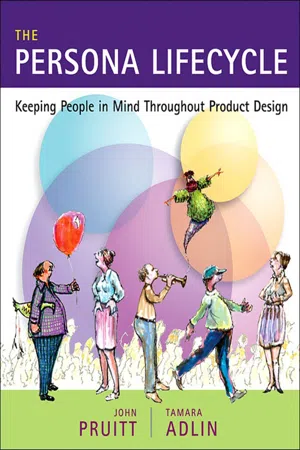![]()
1
THE NEXT FRONTIER FOR USER-CENTERED DESIGN
Making User Representations More Usable
4 You are already a professional imaginer
5 This book is about building products for people
5 Why do we need personas?
11 Personas help make user-centered design possible
21 User representations are not new and we can learn a lot from the past
36 The next frontier for personas
37 Sounds great! Let’s use personas! … it’s easier said than done
42 This book is designed to fill in the gaps
45 Summary
Imagine all the people, sharing all the world.
You may say I’m a dreamer, but I’m not the only one …
—John Lennon, lyrics from Imagine
We would like to introduce you to Tanner, shown in Figure 1.1. Tanner is a nine-year-old boy who loves to skateboard, play video and computer games, and generally run wild—all of which he prefers to do instead of schoolwork. Tanner doesn’t sit still for long, and would rather spend time interactively on the PC than watch TV. Tanner’s mom is Laura, who likes to say that Tanner holds the record for most Band-Aids required for a single human being. Tanner is a pretty regular kid, except in two significant ways:
• Tanner is the most influential member of a product development team at a midsize software company.
• Tanner is imaginary.
This book is all about powerful imaginary people—personas—who can help you build products that real people actually like to use. Personas are detailed descriptions of imaginary people constructed out of well-understood, highly specified data about real people. We believe that when you use data to create personas, and use personas in a thoughtful way during the product development process, you will:
• Increase your products’ usability, utility, and general appeal
• Streamline your teams’ processes and improve your colleagues’ abilities to work together
• Enable your company to make business decisions that help both your company and your customers
• Improve your company’s bottom line.
Tanner and personas like him are ready and willing to help you do all of this. All you have to do is bring them to life and give them jobs. This book is here to help you do that.
YOU ARE ALREADY A PROFESSIONAL IMAGINER
Whether you realize it or not, imagining people is already part of your job. If you picked up this book, you are probably paid to participate in the design and development of products for people—consumers, workers, and businesspeople of all sorts. You probably also know how difficult it is to understand who these people are: what they want out of your products, how they get things done, the contexts in which they work and live, and how they differ from you. To build your products and build them well, you have had to become a professional imaginer, someone who builds a relatively concrete mental image of the people you imagine will be using your products. You can imagine things about people all day long, but it is difficult to know if the people you envision using your product bear any resemblance to the people who will actually purchase and use your product.
No matter what we are designing, building, or helping to build, we want our products (including software, hardware, consumer goods, and services) to be useful, appreciated, and profitable. We want to help create products quickly and cost effectively, but with the right set of features and good quality. We want these products to hit the market and instantly inspire demand, desire, and loyalty. We want people to use our products repeatedly and happily, encountering just the right functions at the right times and finding that the products grow with them as they develop expertise. We want our efforts to result in products that delight people, and to delight people we have to have some idea of who these people are and what they want.
In the best of all worlds, everyone working on a product would always be thinking of the needs of every person who will ever use the product. Real information about users would inform every decision and the resulting product would perfectly satisfy everyone who uses it. In practice in the real world, however, it is difficult to get everyone working on a product to think about users at all. To deliver on the promise and benefits of user-centered design (UCD), we have to find creative ways of injecting accurate information about real users into the chaotic world of product development.
THIS BOOK IS ABOUT BUILDING PRODUCTS FOR PEOPLE
Somehow, we must find again our sense of individual values, lost in this century of enormous technological advance. This very freedom that mechanical aids are giving us has welded us into unmanageable megalopolises, where people are anonymous numbers and where communication with our fellow man seems a minus quantity. We must restore the warmth and spirit we had in the smaller community. I hope that in our leisure time we will once again know our neighbor—and, if everyone knows his neighbor and learns to live with him, the entire world will be at peace.
—Henry Dreyfuss, Designing for People
[Dreyfuss 1955, p. 261]
This book is intended for anyone who participates in designing and developing products for people. In particular, it is for those of us who think that understanding people and their environments is the first step in, and the ongoing challenge of, creating good products. The methods described in this book will help you turn data about your users into exemplars of the people who will use your product—into “personas.” Personas are clearly defined, memorable representations of users that remain conspicuous in the minds of those who design and build products.
This book addresses the “how” of creating and using personas to design products that people love. Our book doesn’t just describe the value of personas; it offers detailed techniques and tools related to conceiving, creating, communicating, and using personas to create great product designs. We provide rich examples, samples, and illustrations for persona practitioners to imitate and model. Perhaps most importantly, the book describes personas as a method complementing other UCD techniques, including user testing, scenario-based design, and cognitive walkthroughs.
WHY DO WE NEED PERSONAS?
It is a rare product indeed that does everything you want it to do in the way you want to do it. Why? Despite the fact that building products based on what real people need and want seems obvious, putting users (i.e., information about users) truly at the center of the design and development process is extremely difficult. Why is it so difficult to be user centered? The problem is threefold.
First, being user centered is just not natural. Our more natural tendency is to be self-centered, which translates to taking an approach to product design based on our own wants and needs (at times even if we are not actually a user of the product). As Bruce Tognazzini points out, we sometimes even seek out users who are just like ourselves to provide feedback on our designs [Tognazzini 1995, p. 230]. Self-centered design is perhaps better than technology-centered design, but most of the time the people on your product development team are not representative of the target audience for your product. Self-centered design results in inadequate products.
The “forever-blinking” VCR clock is a classic example of self-centered design.
For almost as long as the average American has been alive, people have been driven nuts by the flashing “12:00” of their videocassette recorder’s clock. That flashing “12:00” has become a symbol of technology as tyranny, taunt, impotence, ignorance, intimidation, humiliation, stone in the shoe and pain in the butt. It stands for innovation created without humans in mind. Yet humans have grown to live with it. To expec...

